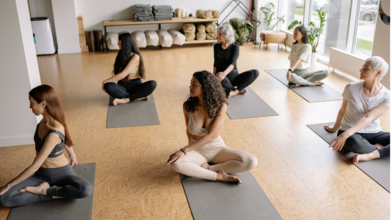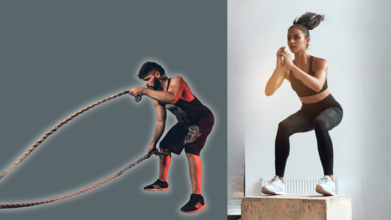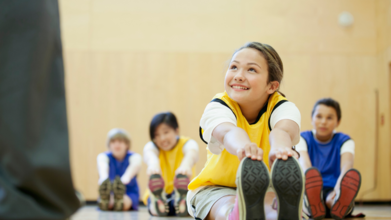- Health Conditions A-Z
- Health & Wellness
- Nutrition
- Fitness
- Health News
- Ayurveda
- Videos
- Medicine A-Z
- Parenting
- Web Stories
Relieve Your Emotional Exhaustion With These Yoga Poses

(Credit-Canva)
Being emotionally overwhelmed can be difficult to deal with. We all have such days when you are exhausted emotionally, it almost seems as if you are unable to do, even necessities. So, dealing with these issues often becomes the problem of how resilient you are and what tools you have learned. Here's where physical activities comes in. Harvard Health Publishing explains that exercising helps us reduce the levels of stress hormones such are adrenaline and cortisol.
Does yoga also play a part in better emotional regulation? Yes, ‘Yoga for better mental health’ by Harvard Health Publishing explains how yoga increases the release of endorphins, which are feel good chemicals your body produce as well as supplies more oxygenated blood in your brain.
Here are some yoga poses you can try if you are feeling emotionally exhausted. Make sure you are not overexerting yourself and practice precaution while performing the poses.
Supported Bridge Pose (Setu Bandha Sarvangasana Variation)
This pose provides deep relaxation by using props to support your body. It gently releases tension held in the upper back and shoulders, areas that often tighten when we experience stress or emotional strain. The support allows the nervous system to settle, promoting a sense of calm and release. Here’s how to do it.
- Lie comfortably on a bolster, a rolled-up blanket, or pillows which ensures your back is supported and your upper back is flat on the floor.
- Take slow, deep breaths, allowing your body to sink into the support.
- Stay in this pose for about 20 breaths, focusing on releasing tension.
Low Lunge Variation (Anjaneyasana Variation)
This variation opens up the front of your body, which tends to become hunched and closed off during periods of stress. The hands supporting the head create a gentle hammock, allowing your neck to relax and your chest to open. This helps to release emotional tension and promotes a feeling of openness and vulnerability.
- Step one foot forward into a low lunge position.
- Bring your hands behind your head, interlacing your fingers to support it.
- Gently lean back, opening your chest and throat.
- Hold this pose for approximately 5 breaths, focusing on the stretch in your front body.
Pyramid Pose Variation (Parsvottanasana Variation)
This pose utilizes gravity to release tension while simultaneously opening the chest and back. The addition of Gomukhasana arms provides extra support for a gentle forward bend. This combination allows for a deeper stretch, helping to release emotional and physical tightness, and promoting a sense of calm and groundedness.
- Stand with one foot stepped back, creating a wide stance.
- Use a strap or towel to perform Gomukhasana arms, and gently lean forward from your hips.
- Hold this pose for about 8 breaths, focusing on the stretch in your hamstrings and the opening in your chest.
Little Thunderbolt Pose Variation (Laghu Vajrasana Variation)
This pose lengthens the front of the body, stretching from thighs to throat, and encourages feelings of trust and surrender. It helps to release emotional blockages and promotes a sense of vulnerability, allowing you to let go of control and find inner peace.
- Kneel on the floor, using blocks behind you for support.
- Lean back, arching your spine and allowing your head to gently rest on the blocks.
- Repeat this movement, holding the pose for about 5 breaths each time, focusing on the stretch in your front body.
Reclining Tree Pose (Supine Vrksasana)
This is a gentle hip opener and lower back release, which also allows for a deeper opening of the chest. It helps to release tension in the hips and lower back, promoting a sense of calm and relaxation, and aiding in emotional release.
- Lie on your back, bring one heel toward your inner thigh, and allow your knee to open out to the side.
- Relax your arms and breathe deeply.
- Hold this pose for approximately 10 breaths, focusing on releasing tension in your hips and lower back.
Reclining Spinal Twist Variation (Supta Matsyendrasana Variation)
This gentle twist releases tension in the spine and promotes a sense of calm and relaxation. It helps to "wring out" emotional and physical tension, leaving you feeling refreshed and renewed. This pose also helps to improve flexibility and mobility in the spine.
- Lie on your back, drop your knees to one side, and turn your head in the opposite direction.
- Repeat this movement on the other side, holding each twist for a comfortable duration.
- This helps to release tension in your spine and promote relaxation.
Supported Legs Up the Wall Pose (Supported Viparita Karani)
This pose transforms feelings of pressure into softness, promoting deep relaxation and calm. It helps to relieve stress and anxiety, and promotes a sense of peace and tranquility. This pose is particularly effective for calming the nervous system and promoting restful sleep.
- Lie on your back, place a block or bolster under your hips, and raise your legs up the wall or toward the sky.
- Hold this pose for 3-5 minutes, allowing your body to fully relax and release tension.
3 Common Yoga Mistakes That Could Be Limiting Your Progress

Yoga, at its heart, is a journey of balance, patience, and self-awareness. Yet, even regular practitioners can unknowingly fall into habits that limit progress or compromise the essence of the practice. Celebrity nutritionist Rujuta Diwekar, who works with stars like Kareena Kapoor, Alia Bhatt, Varun Dhawan, Saif Ali Khan and Karisma Kapoor, recently shared three common yoga mistakes that many of us make and how to correct them. Her advice is simple, practical, and rooted in tradition.
1. Always Starting With the Right Side
The first, she says, is starting every asana from the right side. “Because what happens is that we stay on the right side for a long time and on the left side for a short time. And because of that, the weakness of the left side remains. And the overall imbalance in the body also remains.”This habit, she explains, can unconsciously deepen the existing imbalances in the body. Yoga, after all, is a practice of samatva or balance. The aim is not to favour one side but to restore equilibrium—physically, mentally, and emotionally.
She suggests a simple correction. Yoga should be done with awareness. She says how even sitting postures like Sukhasana should be alternated to ensure both sides of the body are equally engaged. Start from the weaker or underused side. It may feel awkward initially, but over time, it helps realign the body and build balanced strength.
2. Only Practising the Asanas You Are Good At
Rujuta points to the second mistake: “The asanas that we like or that we know well, we practise those asanas again and again. So the ones that we do not know, we do not even reach the lanes of those asanas.”This is a common pitfall. We gravitate towards what feels familiar and comfortable. But yoga is not meant to keep us within our limits; it is meant to gently stretch them. She encourages practitioners to explore the lesser-known asanas, especially those we tend to avoid, like backbends or twists. “We should go to their lanes, we should practise them, and we should have patience with ourselves. Little by little, every asana, especially backbends, will also come.”
She reminds us, “Yoga is not for show-offs. Yoga is for strength. For inner strength. This practice is not for outsiders.” It is a deeply personal journey, and real growth lies in consistency and courage, not perfection.
3. Skipping Practice When Time Is Short
The third and perhaps most relatable mistake is an all-or-nothing mindset. “If we do not have all the time, then we do not practise any asana at all,” Rujuta points out.But this is not how yoga works. “If you do not have time for 12 Surya Namaskars, then do 6. If you do not have time for 6, then do 3. But do it.” Even five minutes of mindful movement can bring enormous benefits. Over time, it is the commitment, not the duration, that matters most.
She also urges balance between the physical and the subtle. “If you are doing pranayama only every day, then do asanas also. If you are doing asanas only every day, then do pranayama once a month.” Her advice is to explore and embrace all aspects of yoga. That way, even if your routine is limited, it is never lopsided.
Yoga is not about being perfect in every pose. It is about showing up. “In your asana practice, explore the key aspects of yoga a little bit,” says Rujuta. “And give this gift of yoga to yourself in your lifetime.”
Whether you are a beginner or a seasoned yogi, her words are a gentle but firm nudge back to the basics. Do not let routine, comfort, or lack of time come in the way of your practice. As she sums up beautifully, yoga is a gift and one worth giving yourself every single day.
What Happens To Your Body When You Do HIIT Workout Daily?

Credits: Health and me
High-Intensity Interval Training or HIIT has become fitness’s darling for its efficiency: short sessions, intense output, and real results. You burn fat fast, build strength, and maybe even get a runner’s high without logging miles. Still, that thrill can hide a dilemma: doing HIIT every day may do more harm than good. Even as it offers potency, it also pumps up cortisol—the stress hormone—and that’s where things start to tilt.
According to fitness experts, high-intensity workouts trigger cortisol, elevating heart rate, breathing, and blood pressure. That’s fine in controlled bursts—it’s how HIIT pushes your body to adapt. But if your training cadence is relentless and stress from life piles on (say, the pandemic years), your body stays locked in fight-or-flight mode. What feels productive could quietly erode your metabolism, immunity, mood—and long-term health.
HIIT—high-intensity interval training—delivers power-packed bursts of effort, short recovery, and tangible results. You get calories burned, stamina boosted, and even mental focus sharpened in less time than traditional workouts but push too hard, too often, and your body begins to push back. Daily HIIT can shift from performance enhancer to internal stressor, if you're not careful.
Heart
HIIT is exceptional at improving cardiovascular efficiency. Studies consistently show gains in VO₂ max, improved blood vessel flexibility, and better insulin sensitivity—even more so than with steady-state cardio. HIIT reduces resting blood pressure and strengthens the heart’s pump function but when the heart is taxed day after day without rest, it can get overworked—especially if you already have an underlying condition. Overdoing it may result in undue stress on the heart, making symptoms like dizziness or chest tightness warning signs, not badges of dedication.
Metabolism
One of HIIT's biggest draws is the metabolic afterburn—or EPOC: your body brûle calories long after you've wiped the sweat away. It’s efficient, effective, and time-friendly. In studies, HIIT matches or surpasses moderate-intensity exercise in fat loss, waist reduction, and insulin sensitivity.³¹ But metabolic stress isn’t just positive. Without proper recovery, the gains plateau or reverse, especially if cortisol stays elevated.
Hormones and Cortisol
When you push your lungs and heart hard, your body ramps up cortisol—the fight-or-flight hormone. Short-term, that's fine but on a daily back-to-back schedule, cortisol becomes chronic. That’s when fatigue, irritability, sleep disruption, weight gain, and even immune suppression show up. Long-term HIIT without recovery doesn't just train your body—it stresses it.
Immunity Takes a Beating
Moderate exercise can boost your defences but constant high-intensity training changes the game- your immune system flags, white cells dip, and healing slows. In research and fitness communities, daily HIIT is linked to more colds, longer recovery, and increased inflammatory markers. That kind of vulnerability is a clear red flag.
Muscles, Joints and High-Impact Risk
Many HIIT workouts involve jumps, sprints, and explosive movements—all great for power, even better for injury risk. Your knees, ankles, shoulders, and back become targets if fatigue or poor form sets in. Routine high-impact HIIT plus weak stabilizers is a recipe for sprains or tendon issues. Recovery days—and movement diversity—are essential damage control.
Cellular and Mental Benefits
When used wisely, HIIT stimulates mitochondrial growth, boosting your cellular energy power. It sharpens cognitive function, supports mood, and improves overall endurance. But this adaptation happens in the recovery phase—not in the push. Without rest, your cells don’t strengthen—they stall.
Safe Way to Do HIIT Workouts
HIIT is one of the most effective training methods out there—it boosts endurance, burns fat, and saves time. But doing it daily without allowing your body to recover? That’s where it starts to backfire.
Pushing through fatigue may feel like dedication, but overtraining from constant HIIT can leave you sore, exhausted, and more prone to injury. Your muscles, joints, and immune system all need time to bounce back. And if they don’t get it, your performance declines—even if you’re working harder than ever.
Your body doesn’t get stronger during workouts; it gets stronger during rest. Recovery is when your muscles repair, your nervous system resets, and your gains actually lock in.
If you’re serious about results, treat recovery as part of the plan, not an afterthought. Two to three HIIT sessions per week, paired with rest or lower-impact training like strength, walking, or yoga, is more than enough for long-term progress. Listen to your body—fatigue, soreness, and poor sleep are signs you may be overdoing it.
Consistency is key, but so is knowing when to hit pause. That’s the real secret to sustainable strength.
Experts universally recommend 2–3 HIIT sessions per week—no more—with at least 24–48 hours between for recovery. That leaves room for walking, strength, flexibility, or restorative movement while giving your body time to adapt. Smart training means crafting a fitness week, not just firing off daily sprints.
HIIT works when you let it. Daily abuse wears you down. For lasting strength, resilience, and mental clarity, couple your intense interval sessions with recovery, variety, and respect. The gains you get may be invisible by the minute, but over time, they shape a fitter, stronger you.
Trump Orders Return Of School Exercise Challenge After A Decade In US: What Is The Presidential Fitness Test?

Credits: Canva
In a move that has already sparked national debate, President Donald Trump signed an executive order reinstating the once-standard fitness benchmark for American students. The announcement, made alongside professional athletes like golfer Bryson DeChambeau and NFL star Harrison Butker, marks the revival of a decades-old program once intended to promote physical excellence in youth—but which has since drawn criticism for its mental and physical demands.
This return isn’t just about nostalgia. It’s part of a broader initiative that ties into Trump’s sports-focused agenda during his second term and America's preparation to host major sporting events such as the 2025 Ryder Cup, the 2026 FIFA World Cup, and the 2028 Summer Olympics. The rollout of the revived test will be overseen by Health and Human Services Secretary Robert F. Kennedy Jr., who has been vocal about what he calls the “childhood chronic disease crisis.”
The newly revived test is part of the “Make America Healthy Again” agenda championed by Kennedy. His May report emphasizes troubling trends: declining youth activity, climbing obesity rates, and increased incidence of chronic diseases in children. The executive order claims that these trends “weaken our economy, military readiness, academic performance, and national morale.”
Trump’s order reestablishes the President’s Council on Sports, Fitness, and Nutrition, instructing it to develop updated test criteria. It will partner with athletes, sports organizations, and public figures to create what the administration calls a “culture of strength and excellence.”
According to the order, declining fitness among American youth is “a threat to the vitality and longevity of our country,” particularly as the nation approaches its 250th birthday in 2026.
What Was the Presidential Fitness Test?
To understand why this announcement is stirring such heated debate, it's worth revisiting what the test actually involved.
The original Presidential Fitness Test was formalized in 1966 under President Lyndon B. Johnson but was rooted in a much earlier concern about American children's physical fitness. In the 1950s, orthopedic surgeon Hans Kraus and exercise expert Bonnie Prudden found that nearly 60% of American children failed their six-part strength and flexibility test—compared to fewer than 10% of European children. Their findings shocked President Eisenhower and led to the creation of the President’s Council on Youth Fitness.
Over time, the test evolved into a yearly challenge for students aged 6 to 17, usually featuring:
- A one-mile run to measure cardiovascular endurance
- Sit-ups performed within one minute
- Pull-ups or push-ups to test upper body strength
- Sit-and-reach flexibility assessments
- Shuttle run drills to evaluate agility
Students who scored at or above the 85th percentile received the prestigious Presidential Physical Fitness Award. Others received participation certificates.
Why It Was Scrapped in 2012?
Despite its long-standing legacy, the Presidential Fitness Test was phased out during the Obama administration. It was replaced by the Presidential Youth Fitness Program, which emphasized personal health goals over athletic performance. The change was backed by growing concerns around mental health, body image, and the test's "one-size-fits-all" approach.
Educators and health professionals had begun to criticize the test as an outdated model that humiliated students rather than encouraged them. The Centers for Disease Control and Prevention (CDC) reported that even while the test was in place, obesity rates continued to rise—from 13% in 1960 to 34% in 2008—calling into question its effectiveness.
Instead, the new program focused on achievable, individualized goals and health improvements, guided by modern science rather than outdated percentile charts.
Why Bring Presidential Fitness Test Back Now?
So why return to a system that was largely discredited? According to the administration, the decision is tied to more than just fitness—it’s about national identity.
The upcoming 250th anniversary of the United States and its hosting of global sporting events create a symbolic moment to spotlight strength, unity, and youth development. Trump’s team sees physical fitness as an avenue for national pride and global competitiveness, especially as statistics continue to show American youth falling behind in basic health markers.
Secretary Kennedy has also argued that the current generation is experiencing an unprecedented rise in chronic disease, inactivity, and poor dietary habits—problems he believes need stronger interventions than what current programs provide.
Although the exact criteria for the new test haven’t been released, the White House says it will retain some traditional components while modernizing the structure. DeChambeau, now chairing the President’s Council on Sports, Fitness, and Nutrition, has hinted that flexibility, endurance, and strength will remain central to the updated test.
Implementation may begin as early as the next academic year, although many details—such as whether participation will be mandatory, how the test will account for students with disabilities, and what changes might be made to avoid previous mental health criticisms—remain unclear.
Is This A Fitness Test or a Cultural Flashpoint?
For many, this isn’t just a test—it’s a reflection of deeper cultural tensions. Supporters argue the return of the Presidential Fitness Test is a much-needed wake-up call for a generation growing increasingly sedentary and disconnected from physical activity. Critics, however, see it as a regressive move that prioritizes performance over wellbeing.
Organizations like the American Academy of Pediatrics and National Association for Sport and Physical Education have yet to weigh in formally, but past criticism suggests skepticism. Questions remain about the scientific basis of the test, its potential mental health effects, and whether it will be implemented fairly across diverse school populations.
Bringing back the Presidential Fitness Test might appeal to those nostalgic for dodgeball days and presidential awards, but it also reopens debates that never really went away. At its best, the test was a motivator and a symbol of excellence. At its worst, it was a public performance of failure for students who didn’t fit the mold.
© 2024 Bennett, Coleman & Company Limited

